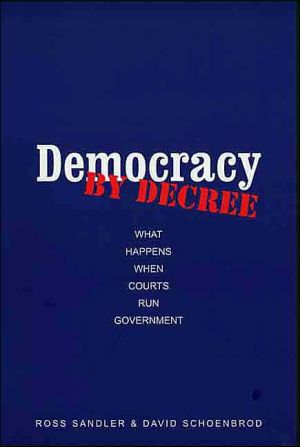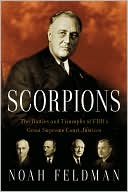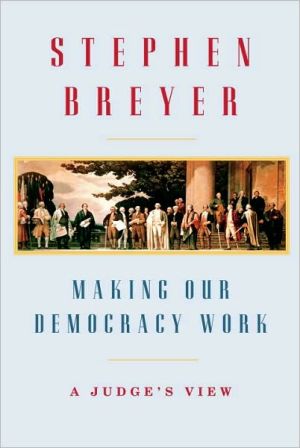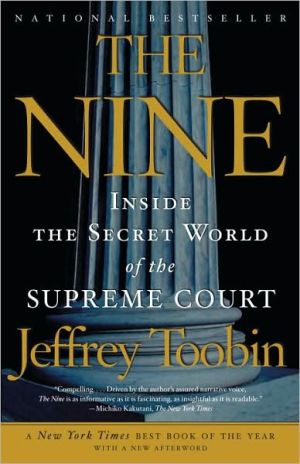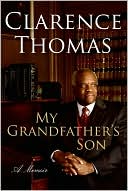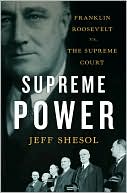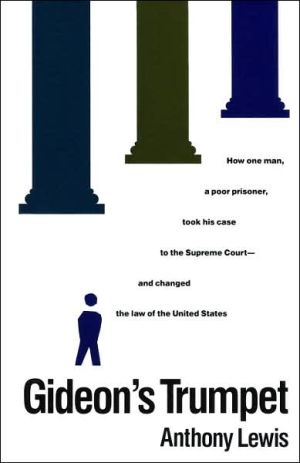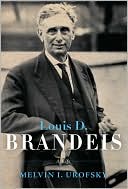Democracy by Decree: What Happens When Courts Run Government
This valuable book explains why schools, welfare agencies, and other important state and local institutions have come to be controlled by attorneys and judges rather than by governors and mayors. The authors discuss why this has resulted in worse service to the public and what can be done to restore control of these programs to elected—and accountable—officials.\ “A brilliant, well-written and brave account of how federal courts have distorted our political system by taking control of complex...
Search in google:
This valuable book explains why schools, welfare agencies, and other important state and local institutions have come to be controlled by attorneys and judges rather than by governors and mayors. The authors discuss why this has resulted in worse service to the public and what can be done to restore control of these programs to elected—and accountable—officials.“A brilliant, well-written and brave account of how federal courts have distorted our political system by taking control of complex institutions like schools and prisons—sometimes for decades—instead of enforcing rights, which is their proper domain.”—Diane Ravitch, New York University“A thought-provoking book about the fundamental issues of democracy, federalism, and separation of powers.”—Ross Weiner, Legal Times“This book shows how well-meaning efforts to fix society’s problems often fail because the judiciary is badly equipped to enforce such changes.”—Jonathan Shapiro, Washington Post“An elegant volume.”—Harvard Law Review
Democracy by Decree\ What Happens When Courts Run Government \ \ By Ross Sandler \ Yale University Press\ Copyright © 2004 Ross Sandler\ All right reserved.\ ISBN: 030010314X \ \ \ \ Chapter One\ How Courts Came to Govern \ At 7:53 A.M. on December 7, 1941, Japanese bombers struck U.S. naval bases on Oahu, Hawaii, killing 2,403 U.S. military personnel and citizens. Not included in the official casualty count but nonetheless a victim of the attack was an evil fellow named Jim Crow.\ World War II put soldiers of diverse skin colors in motion around the country. Northern whites witnessed segregation in the South, and southern blacks experienced the freer, but still deeply flawed, ways of the North. The blood they shed overseas was all the same color. The common enemy, Adolf Hitler, exemplified the evil in the claims of racial superiority that gave Jim Crow life. The war called into question the governmentally imposed second-class status of blacks. The cultural tide was turning, as became clear when President Harry S. Truman ended official segregation in the military in 1948.\ Although most southern whites still believed in segregation, they were on a collision course with history. Northern businesses, which controlled the lion's share of the nation's investment funds, were reluctant to invest in the Deep South, leaving it an economic backwater. Segregation was also increasingly indefensible in the world arena. Great Britain ceded independence to India in 1947, formally shrugging off the "white man's burden." In the Cold War struggle of imagery and ideas with the Soviet Union, Jim Crow was a dangerous embarrassment to the United States.\ Segregation was doomed, but just when and how it would end was not foreordained. Nor was it fated that Thurgood Marshall and his colleagues working with the NAACP Legal Defense Fund would play the pivotal roles they did.\ Massive Resistance\ Marshall and others who mapped the litigation campaign to end school segregation began without power. The African Americans among them had been brought up in a society that threatened to lynch those who protested their subservient status. Nonetheless, they litigated throughout the South in the late 1940s and early 1950s, with no assurance that they would win. The only certainty was that they would have to bear daily indignities, such as having to eat their lunches huddled in a car because no restaurant would seat them.\ Finally, in the 1954 case of Brown v. Board of Education, the Supreme Court handed down the decision for which Marshall and his colleagues had so long striven. The Court declared school segregation unconstitutional. It took considerable courage for Chief Justice Earl Warren and his colleagues on the bench to issue this unanimous, politically charged, precedent-breaking decision.\ Yet Brown itself made hardly a dent in segregation. Southern politicians launched a counterattack. Citing constitutional theories reversed by the Civil War, they claimed the right to disregard Supreme Court decisions with which their white constituents disagreed. To keep African Americans out of the schools and "in their place," these officials organized what they termed "massive resistance." They blocked schoolhouse doors, declaring, "Segregation today, segregation forever." Sheriffs used cattle prods on peaceful demonstrators. Governors egged white mobs into action-and it appeared for a while that the mobs might win. Some federal judges abetted the resistance; those who tried to enforce the law got only grudging support from Presidents Dwight D. Eisenhower and John F. Kennedy. For a while, the "massive resistance" threatened to nullify the Supreme Court's decision in Brown.\ Backlash in the South produced a counter-backlash in the rest of the nation. Television, a new force in American politics, brought the mobs defending "The Southern Way of Life" into America's living rooms. As Professor Alexander Bickel of Yale Law School wrote in 1962:\ Here were grown men and women furiously confronting their enemy: two, three, a half dozen scrubbed, starched, scared, and incredibly brave colored children. The moral bankruptcy, the shame of the thing, was evident.... There was an unforgettable scene, for example, in one CBS newscast from New Orleans, of a white mother fairly foaming at the mouth with the effort to rivet her distracted little boy's attention and teach him how to hate. And repeatedly, the ugly spitting curse, NIGGER! The effect achieved on an unprecedented number of people with unprecedented speed, must have been something like what used to happen to individuals (the young Lincoln among them) at the sight of an actual slave auction.... Mob action led to the mobilization of northern opinion in support of the Court's decision-not merely because the mob is disorderly, but because it concretized the abstraction of racism.... One of those supreme occasions had been brought about when a decisive reprise is open to the political branches; it was for them to make the Court's decision their rule of political action, or not to do so, and thus to make or break the decision itself. The political branches ... had independently, on their own responsibility, to speak their moral approval of the Court's decision, to support it by drawing on their own resources, and to act in pursuance of it. This was one time when hiding behind the judges' skirts would not do. The political institutions had a decision of their own to make.\ Congress and the president decided in favor of equal rights because the electorate, shocked by these ugly images, demanded it. In 1964, they began enacting antisegregationist statutes with teeth. Instead of passing the buck-instead of telling federal agencies to pursue a melange of goals designed to please everyone-elected officials straightforwardly outlawed the practices that kept African Americans out of schools and voting booths. To ensure that these new laws were obeyed, Congress gave the Department of justice the authority, funding, and political backing it needed to sue in the name of the United States. The Department of Health, Education, and Welfare was meanwhile instructed to cut off federal money to school districts that failed to desegregate.\ Brown v. Board of Education and the ten years of litigation that followed produced hardly any practical change in the field, but what Congress did beginning in 1964 brought massive change. With Brown, the Supreme Court had not so much imposed its values on society as called the question of whether Jim Crow should live on. Society answered by coming down decisively against racism.\ Southern politicians hollered "states' rights." This principle-that national government should stay out of the affairs of state and local governments and that also goes by the name federalism-has validity but was a loser in the context of desegregation. Federalism had never stopped federal judges from protecting other constitutional rights, and the Supreme Court had decided that school segregation violated the Constitution. State elected officials who asserted states' rights were temporarily popular in their own districts but were soon overwhelmed by the social forces sweeping the country. America in the end honored the judges who enforced desegregation decrees as strong and wise and visionary. These assertive judges and the civil rights lawyers who appealed to them were the heroes of the day.\ Yet federal courts did more than stop constitutional violations in the desegregation cases. Ongoing resistance to compliance with the law forced federal judges to undertake the policy-making work of school boards and, later, prison wardens. Understandably, the judges wanted the institutions under them to become not only legal, but better. From the death of Jim Crow, there was thus born a revolutionary idea: that courts could and should reform state and local governments.\ Congress Cashes In\ The image of state and local officials as villains in need of judicial correction began with the South but spread to officials across the country during the era of antiwar demonstrations and urban riots. In the resulting culture, mayors and governors came to be considered part of the problem rather than the solution. Local politics that set priorities through democratic tugging and hauling reflected, many young lawyers thought, the basest instincts of society. They wanted to use the courts to improve society just as the heroes of Brown had done before them. Marcia Lowry, who filed the Wilder case, was one of them. We were, too.\ In the late 1960s, with southern segregation on the run, the moral spotlight turned to poverty and the environment. Books such as Michael Harrington's The Other America (1962) and Rachel Carson's Silent Spring (1962) made the public aware that poverty and pollution, like racial segregation, were the unfinished business of the American dream. As with racial segregation, national leaders blamed these failures on state and local officials.\ Congress responded to these new challenges by creating statutory rights enforceable in federal court against state and local governments. Before Brown, Congress had created few such rights. Congress, to be sure, had vastly increased national regulation of society in general and business in particular, but it had largely exempted state and local governments or gave them separate, more lenient treatment. The chief way in which Congress influenced state and local governments was by giving them money with strings attached. The strings were in the main aimed at getting state and local governments to spend the federal money for its intended use-highway money for highways, housing money for housing-and were not aimed at using the federal purse for regulating state and local governments. State and local officials sometimes complained that spending conditions were too complex or constricting, but enforcement was generally by the federal agency, which might negotiate a plan to achieve eventual compliance but almost never would turn off the money tap.\ In addressing the civil rights challenge, Congress adopted a different strategy. Faced with defiance from elected state and local officials, Congress opted to act primarily through federal agents, especially U.S. marshals, federal voting inspectors, Department of justice attorneys, and federal judges. Congress followed a similar pattern in President Lyndon B. Johnson's 1965 War on Poverty, in which federal officials worked directly with local poverty organizations rather than through existing state and municipal channels. This was the concept of maximum feasible participation, which proved disastrous, as so brilliantly narrated in Daniel Patrick Moynihan's Maximum Feasible Misunderstanding.\ As the Voting Rights Act started to make states in the South more responsive to African Americans, Congress reverted to its more traditional means of getting its way: it tied federal money to federal standards. This well-worn strategy had the great advantage of interposing states and cities as buffers between the federal government and the beneficiaries of the social programs and also allowed Congress to observe the niceties of federalism.\ Congress increasingly used spending conditions to regulate how states and cities ran programs that they had long funded and operated on their own. Governors and mayors had little choice but to comply, as leaving federal funds on the table would be political suicide. This fiscal federalism or regulatory federalism, as it came to be called, was the tool by which the federal government imposed national standards on traditional state programs such as education, welfare, medical assistance, water quality, and highway construction.\ Although our topic is court management of state and local governments, not fiscal federalism, fiscal federalism is an essential ingredient in how courts came to govern. Fiscal federalism called for a new governmental lineup. The federal government assumed the senior role of setting standards on how and when states and localities would deliver services. To get the federal money, governors and mayors had to promise to dance to the federal tune.\ But who would make sure that the governors and mayors delivered on the promises they gave to secure the federal money? Answer: the courts. They stood at the ready. Judge Skelly Wright of the District of Columbia Court of Appeals expressed in 1971 the spirit of the times: "Our duty, in short, is to see that important legislative purposes, heralded in the halls of Congress, are not lost or misdirected in the vast hallways of the federal bureaucracy."\ Members of Congress, quick to perceive changes that work to their advantage, latched on to the courts' willingness to supervise state and local governments as a way to crown themselves with the heroic mantel of rights-bestower. The prospect of legislating popular generalities and leaving them to be fleshed out by the courts was especially enticing. After all, what makes the work of elected politicians hard-and makes reelection even harder-is the clash of interests. For one example, those who want factories to reduce pollution clash with management, shareholders, customers, and employees, all of whom have an interest in avoiding the expense of pollution control. Politicians who dare enact rules resolving such clashes often come away feeling that they made more enemies than friends. If the policy-making burden were shifted to the courts, national legislators could have their cake and eat it, too. They could take credit for bestowing rights while lawyers and judges forced state and local officials to shoulder the blame for the costs. The state and local officials would have to impose the higher taxes, tougher regulations, or service cuts needed to comply with the federal mandates. This ploy came to be known among political types as the unfunded mandate.\ Starting with the 1970 Clean Air Act, Congress gave everyone a right to healthy air. Who had the corresponding duty to clean it was not specified. The federal lawmakers passed that buck to the elected branches of state and local government by setting up an elaborate process in which state and local officials would have to decide who had to reduce their emissions and how much. To deflect the charge that this new right to clean air was not just hot air, the act authorized citizens to sue in court. The courts, not Congress, became the place where clean air policy would be made.\ The state and local officials were not to blame for the dirty air, or no more to blame than Congress, but that was beside the point.\ \ Continues...\ \ Continues... \ \ \ \ Excerpted from Democracy by Decree by Ross Sandler Copyright © 2004 by Ross Sandler. Excerpted by permission.\ All rights reserved. No part of this excerpt may be reproduced or reprinted without permission in writing from the publisher.\ Excerpts are provided by Dial-A-Book Inc. solely for the personal use of visitors to this web site. \ \
PrefaceIntroduction: The Legal Hook11How Courts Came to Govern132How Congress Creates Rights: A Case Study353How Courts Enforce Rights: A Case Study454Something New Is Going On In Court985How Court Management Works1136A Good Thing Gone Wrong1397Why the Wrong Thing Continues1628Road to Reform1839New Principles193Summary and Conclusion223Appendix229Notes239Acknowledgments269Index275
\ From the Publisher“A compelling story with a powerful argument backed by lots of fascinating stories about judicial shipwrecks.”—James B. Jacobs, New York University School of Law\ "Democracy by Decree shows how courts can protect rights and still let mayors and governors do their job.”—John Sexton, president of NYU and dean of NYU Law School\ “A brilliant, well-written and brave account of how federal courts have distorted our political system by taking control of complex institutions like schools and prisons--sometimes for decades--instead of enforcing rights, which is their proper domain.”\ --Diane Ravitch, New York University\ \ \ \
